#archaeological museum of kissamos
Photo
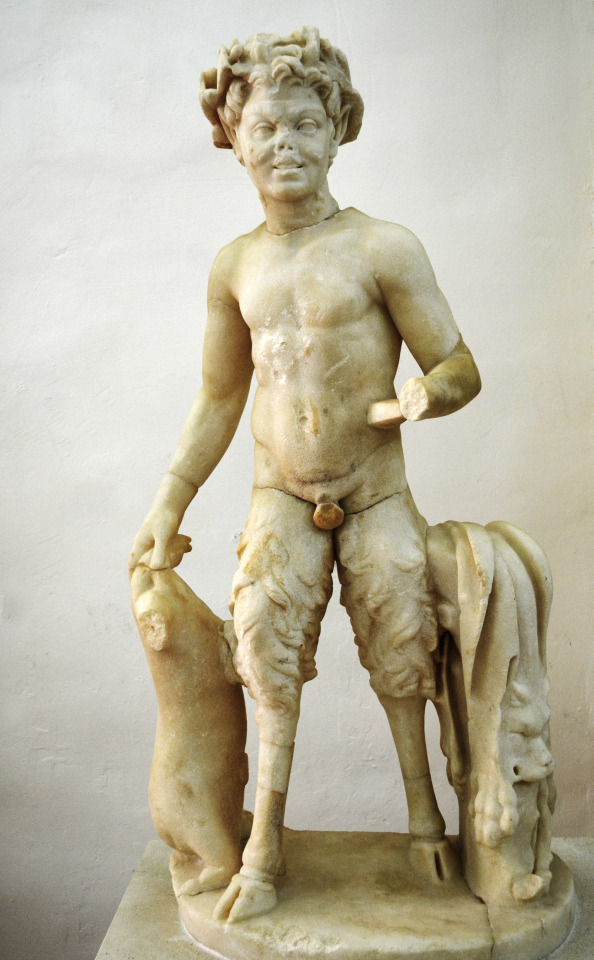

Crete, Archaeological Museum of Kissamos:
(Λ419) Found in Kissamos, eastern Roman baths, 2005. Marble statue of a young Pan with characteristics of a Satyr. He is holding a hare in his right hand. Roman copy of a Late Hellenistic prototype. Its style is similar to that of the Satyr (694). Date 2nd century A.D
This statue was found crushed in the Roman baths, possibly from the 365 A.D earthquake, this photo is from the excavations - part of the museum exhibition.
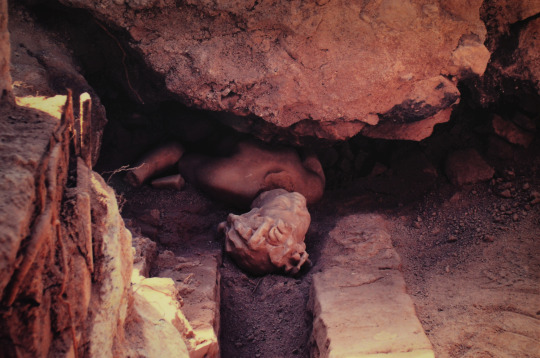
The Earthquake of 365 A.D.
During the night of July 21, 365 A.D. a terrific earthquake of 8.5 Richter magnitude destroyed Kissamos and other Cretan and Mediterranean cities. It triggered a tsunami that reached the Nile delta and is a possible cause of the uplift of Western Crete. This earthquake signalled the decline of the city and the end of the ancient, pagan world in this area.
Finds from the destruction level include coins and ceramics in accord with the chronology of the earthquake, four human skeletons crushed under the ruins, and intense burning on the floors from fires probably caused by fallen oil lamps. The first evidence of survival are outdoor ovens and cooking hearths constructed on top of the destruction debris.
#greece#crete#archaeological museum of kissamos#grecoroman statuary#pan#ancient greece#tagamemnon#statuary#archaeological museums#greek museums#ελλάδα#κρήτη#κίσσαμος#καστέλι#ελληνικά μουσεία#αγάλματα#sculpture#statues#archaeology
335 notes
·
View notes
Text
Fossil footprints of early human ancestor stolen from archaeological site in Kasteli, Crete

A number of fossilised footprints believed to belong to a hominid ancestor of modern humans have been stolen from Kissamos archaeological site on Crete island in Greece, by a person or persons unknown, authorities revealed on Thursday. Ten of some 40 footprints on the Kasteli site have been cut away and removed from the rock, where they were found by a Polish paleontologist in 2002.
The theft was discovered by a member of the public that visited the site on Tuesday and alerted local police, and was later confirmed by the Natural History Museum of Crete.
Police and scientists are now investigating the case, while Kissamos Mayor Thodoris Stathakis, in statements to the Athens-Macedonian News Agency, noted it raised an issue of protecting cultural heritage sites in the area.
"The issue of showcasing but also protecting antiquities that exist in the region must be dealt with directly," he stressed. Read more.
140 notes
·
View notes
Link
0 notes
Photo
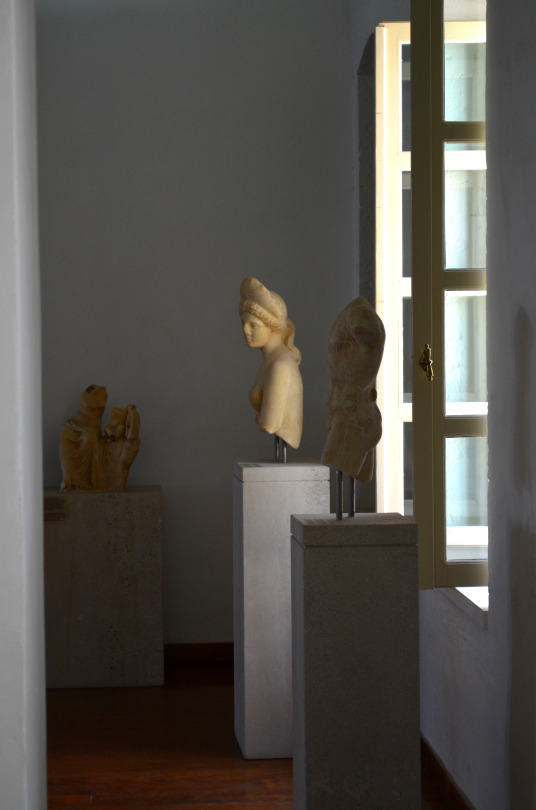

Crete, Archaeological Museum of Kissamos:
Λ418, Kissamos, Raisakis plot 2005, Naked marble torso of Aphrodite wearing a diadem. Roman copy of a Hellenistic prototype from the end of 4th century B.C. It belongs to the type of Capitoline Aphrodite (modest Aphrodite).
#greece#crete#archaeological museum of Kissamos#statuary#grecoroman statuary#archaeology#marble statues#statue#ancient greece#tagamemnon#kissamos#ελλάδα#αρχαία ελλάδα#καστέλι#κίσσαμος#γλυπτική#μαρμάρινα αγάλματα#αρχαιολογικό μουσείο κισσάμου#κρήτη
182 notes
·
View notes
Photo
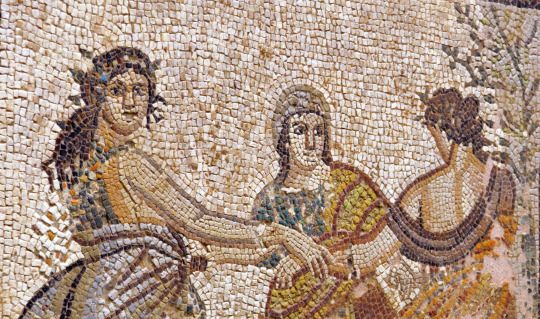


Crete, Archaeological Museum of Kissamos:
Mosaic of Horae and the Seasons
Vasilios Paterakis plot (1979), north side of El. Venizelos Square.
The main composition of a floor mosaic from a dining room (triclinium). The mosaic was extended with three more panels, each with a separate subject/theme a) hunting scene, b) a colourful scroll of living birds, and c) a series of squares with exotic birds and fruits. The dining room was T-shaped and the figural mosaic covered the floor of the vertical (north-south) part of the T. The horizontal bar of the T had mosaics decorated with geometric patterns.
The square composition exhibited consists of the personifications of the four Seasons in the corners, and the mythological Horae with attributes of the Seasons in a circular dance around a circular altar. The tree symbolizes the idea that the Horae are deities of vegetation. The trinity recalls the older, Hellenic division of the year into three seasons. The circular dance symbolizes the renewal of nature. The mosaic’s combination of the four Seasons with the mythological trinity of the Seasons (Horae) is unique.
The rendering of figures, the details, and the movement indicate a skillful artist and recall a lost Hellenistic painting.
Date 2nd half of the 2nd century A.D
The four seasons at the corners of the mosaic.


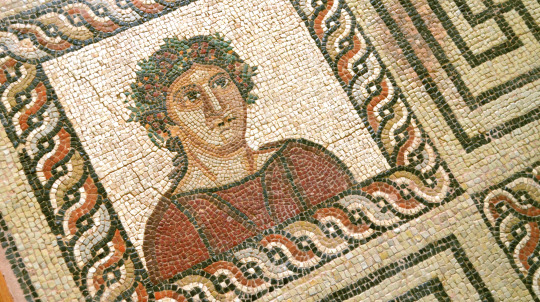
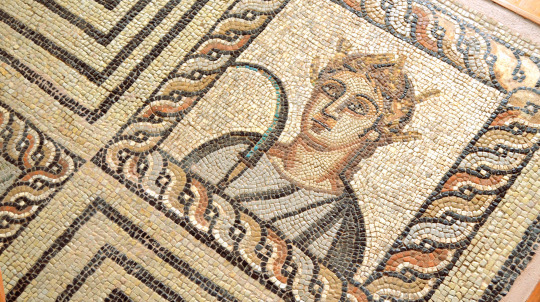
And a full view of the exhibit.
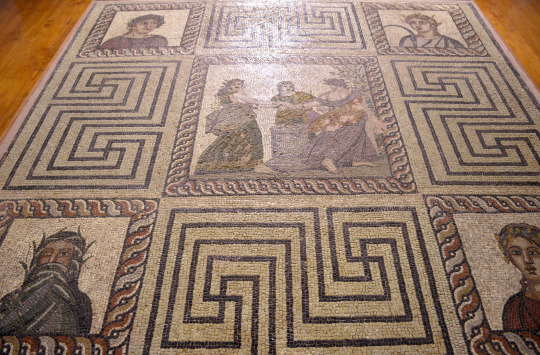
#tagamemnon#greek museums#greco roman period#mosaics#grecoroman mosaics#archaeological museum of Kissamos#art#archaeological museums#greece#crete#ancient greece#kissamos#Ελλάδα#Κρήτη#αρχαιολογικό μουσείο Κισσάμου#αρχαιολογικό μουσεία#μωσαϊκά#Κίσσαμος#Καστέλι#αρχαία ελλάδα#ελληνορωμαϊκή περίοδος
330 notes
·
View notes
Photo
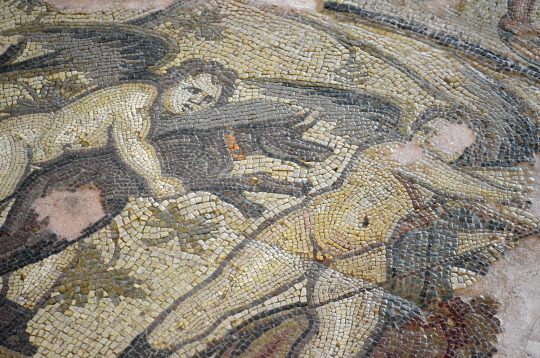



Crete, Archaeological Museum of Kissamos
Dionysiac Mosaic Floor
[Found in] Antonios Skounakis plot (1985), north side of El. Venizelos Square
Mosaic floor of a large reception hall (9,70 x 8,00 meters), oikos or tablinium, oriented east-west.The floor had a 2-2,5 meter wide border on all sides except the entrance side, consisting of a) a meander with swastikas and squares, b) a slender ivy scroll, and c) a wide white band next to the walls. An oblong frieze depicting the return of a hunt is on the entrance side.
The composition follows an interesting iconographic program related to Dionysiac ritual. It is divided in panels, that are framed by curving and interwining vine branches, which mimic ceiling decoration.
The central figures are of Dionysus the Victor surrounded by scenes of a sacred hunt and a symbolic wine press. This mosaic probably belonged to the same villa as the Seasons mosaic (exhibited next to it.) It has many ancient restorations*, evidence of long use for the building.
End of 2nd - beginning of the 3rd century A.D
Image description:
A close up of two cupids restraining their hounds - one of them is hugging the dog.
An image of a bleeding boar with a missing face, attacked by two leaping hounds next to a tree.
Two hounds, led by a leash by a cupid with a big round hat.
A cupid on a rearing horse, and a cupid on foot with a spear attacking and injuring a boar. The cupids frame the boar between them. Above them a partial scene of cupids grape pressing.
Some pictures might appear fuzzy, but they are not, it’s a result of the auto compression to tumbrl’s default sizes.
#tagamemnon#greek museums#greece#ancient greece#mosaics#greek roman period#roman period#archaeological museum of kissamos#crete#kissamos#kasteli#archaeological museums#archaeology#ancient art#κρήτη#καστέλι#ελλάδα#αρχαιολογία#αρχαιολογικά μουσεία#αρχαία τέχνη#μωσαϊκά
490 notes
·
View notes
Photo
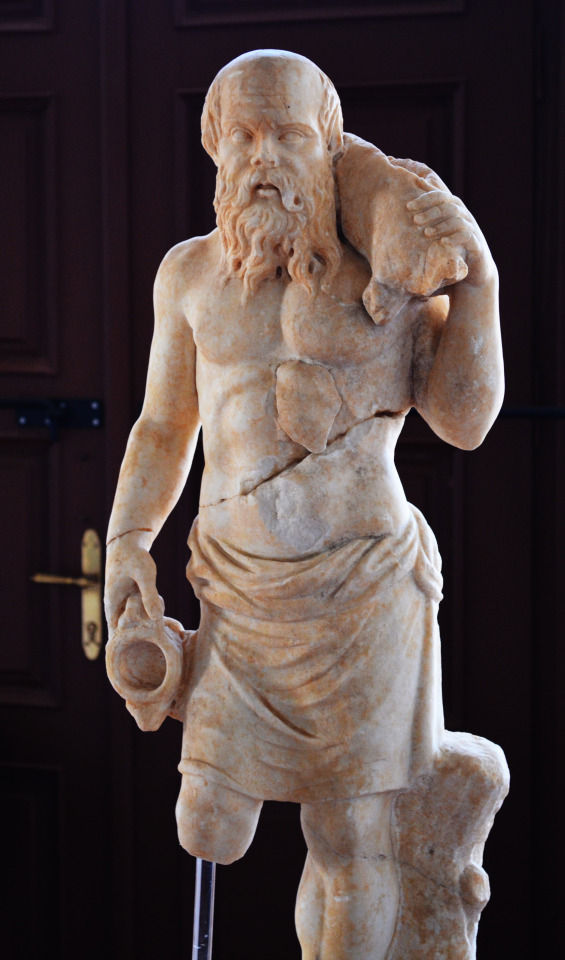
Crete, Archaeological Museum of Kissamos:
Λ3210 Kissamos, El. Venizelos Square 1983. Marble statue of Silinos. The statue worked as a fountain with water flowing from the goatskin on his shoulder. Well polished Parian marble (lychnites). Date 1st 02nd century A.D.
#greece#crete#tagamemnon#archaeological museum of kissamos#kissamos#grecoroman statuary#marble statues#sculpture#greek museums#archaeological museums#ancient greece#silinos#archaeology#ελλάδα#αρχαία ελλάδα#αρχαιολογικό μουσείο κισσάμου#κίσσαμος#καστέλι#κρήτη#γλυπτική#μαρμάρινα αγάλματα
131 notes
·
View notes
Photo
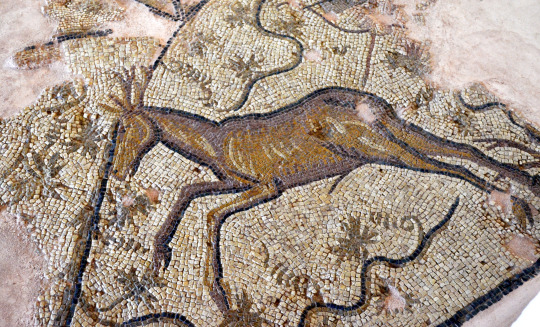

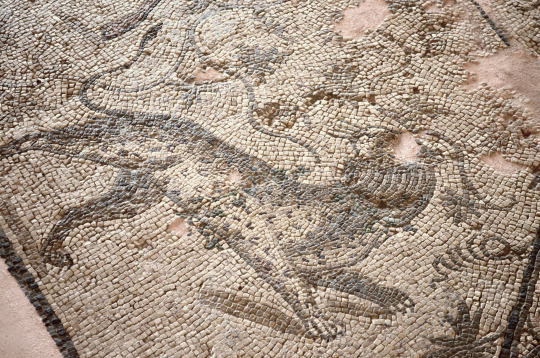
Crete, Archaeological Museum of Kissamos:
Border details from a dionysiac mosaic floor, the rider hunts a jaguar, while a cupid shoots down a leaping deer.
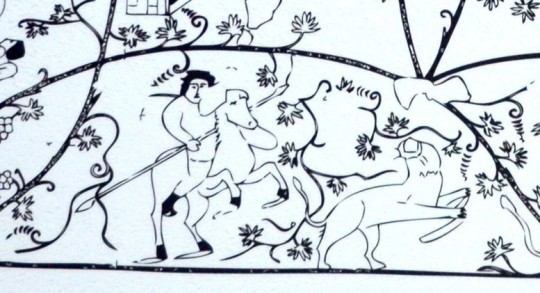
Dionysiac Mosaic Floor, [Found in] Antonios Skounakis plot (1985), north side of El. Venizelos Square
[...]The composition follows an interesting iconographic program related to Dionysiac ritual. It is divided in panels, that are framed by curving and interwining vine branches, which mimic ceiling decoration.
The central figures are of Dionysus the Victor surrounded by scenes of a sacred hunt and a symbolic wine press. This mosaic probably belonged to the same villa as the Seasons mosaic (exhibited next to it.) It has many ancient restorations, evidence of long use for the building.
End of 2nd - beginning of the 3rd century A.D
Consider supporting this blog, and me the photographer for future museum trips and a healthy consumption of caffeinated drinks: https://ko-fi.com/isabia
#ancient greece#tagamemnon#greece#mosaics#ancient art#archaeology#greek roman period#museums#archaeological museum of kissamos#crete#archaeological museum#art#greek museums#archaeological museums#αρχαία ελλάδα#ελλάδα#κρήτη#μωσαϊκά#ρωμαϊκή περίοδος#αρχαιολογικό μουσείο κισσάμου#κίσσαμος#καστέλι
469 notes
·
View notes
Photo

Crete, Archaeological Museum of Kissamos:
Dionysiac Mosaic Floor
[Found in] Antonios Skounakis plot (1985), north side of El. Venizelos Square
Mosaic floor of a large reception hall (9,70 x 8,00 meters), oikos or tablinium, oriented east-west.The floor had a 2-2,5 meter wide border on all sides except the entrance side, consisting of a) a meander with swastikas and squares, b) a slender ivy scroll, and c) a wide white band next to the walls. An oblong frieze depicting the return of a hunt is on the entrance side.
The composition follows an interesting iconographic program related to Dionysiac ritual. It is divided in panels, that are framed by curving and interwining vine branches, which mimic ceiling decoration.
The central figures are of Dionysus the Victor surrounded by scenes of a sacred hunt and a symbolic wine press. This mosaic probably belonged to the same villa as the Seasons mosaic (exhibited next to it.) It has many ancient restorations*, evidence of long use for the building.
End of 2nd - beginning of the 3rd century A.D
*See the presence of the three arms- the one holding the upright spear is probably a later addition.
Detail from a schematic depiction of the mosaic from the museum tag.

The entirety of the mosaic:

------------------
And never forget, greek-museums, the blog, is powered by caffeinated drinks - with whipped cream preferably - and more museum trips. Consider donating: https://ko-fi.com/isabia
#ancient greece#tagamemnon#greece#ancient art#mosaics#greek roman period#archaeology#archaeological museum of kissamos#crete#kissamos#kasteli#museums#greek museums#archaeological museums#αρχαία ελλάδα#ελλάδα#κρήτη#κίσσαμος#καστέλι#μουσεία#αρχαία μωσαϊκά#τέχνη#art#dionysus#διόνυσος
438 notes
·
View notes
Photo

Crete, Archaeological Museum of Kissamos:
Dionysiac Mosaic Floor
[Found in] Antonios Skounakis plot (1985), north side of El. Venizelos Square
Mosaic floor of a large reception hall (9,70 x 8,00 meters), oikos or tablinium, oriented east-west.
The floor had a 2-2,5 meter wide border on all sides except the entrance side, consisting of a) a meander with swastikas and squares, b) a slender ivy scroll, and c) a wide white band next to the walls. An oblong frieze depicting the return of a hunt is on the entrance side.

The floor had a 2-2,5 meter wide border on all sides except the entrance side, consisting of a) a meander with swastikas and squares, b) a slender ivy scroll, and c) a wide white band next to the walls. An oblong frieze depicting the return of a hunt is on the entrance side.
The composition follows an interesting iconographic program related to Dionysiac ritual. It is divided in panels, that are framed by curving and interwining vine branches, which mimic ceiling decoration.
The central figures are of Dionysus the Victor surrounded by scenes of a sacred hunt and a symbolic wine press. This mosaic probably belonged to the same villa as the Seasons mosaic (exhibited next to it.) It has many ancient restorations, evidence of long use for the building.
End of 2nd - beginning of the 3rd century A.D
Detail from a schematic depiction of the mosaic (from the museum tag)

Consider supporting this blog, and me the photographer for future museum trips and a healthy consumption of caffeinated drinks: https://ko-fi.com/isabia
#ancient greece#tagamemnon#greece#mosaics#dionysus#greek roman period#ancient art#archaeology#archaeological museums#museums#greek museums#kissamos#crete#archaeological museum of kissamos#αρχαία ελλάδα#ελλάδα#κίσσαμος#καστέλι#κρήτη#μουσεία#αρχαιολογικό μουσείο κισσάμου#ρωμαϊκή περίοδος#αρχαία μωσαϊκά#μωσαϊκά#τέχνη
423 notes
·
View notes
Photo

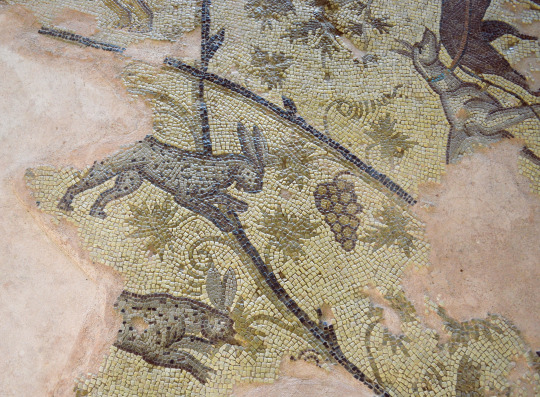

Crete, Archaeological Museum of Kissamos:
Dionysiac Mosaic Floor
[Found in] Antonios Skounakis plot (1985), north side of El. Venizelos Square
Mosaic floor of a large reception hall (9,70 x 8,00 meters), oikos or tablinium, oriented east-west.The floor had a 2-2,5 meter wide border on all sides except the entrance side, consisting of a) a meander with swastikas and squares, b) a slender ivy scroll, and c) a wide white band next to the walls. An oblong frieze depicting the return of a hunt is on the entrance side.
The composition follows an interesting iconographic program related to Dionysiac ritual. It is divided in panels, that are framed by curving and interwining vine branches, which mimic ceiling decoration.
The central figures are of Dionysus the Victor surrounded by scenes of a sacred hunt and a symbolic wine press. This mosaic probably belonged to the same villa as the Seasons mosaic (exhibited next to it.) It has many ancient restorations*, evidence of long use for the building.
End of 2nd - beginning of the 3rd century A.D
Image description: First picture: two cupids restraining their hounds, while another leaps among grapevines. Second picture: two rabbits leaping. Third picture: A cupid riding a horse, followed by a cupid holding a hound on a leash, a big round hat hanging on his back.
The mosaic in its entirety in a schematic depiction on the museum tag:

A detail from the depicted scenes:
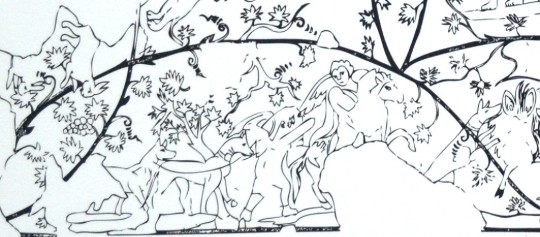
You can find more pictures from this mosaic here, here, and here.
#tagamemnon#greece#ancient greece#mosaics#ancient art#archaeological museum of kissamos#crete#dionysiac mosaic#greek roman period#archaeology#kissamos#kasteli#museums#archaeological museums#cupids#hunt#μουσεία#αρχαιολογία#αρχαιολογικά μουσεία#καστέλι#κρήτη#κίσσαμος#αρχαία τέχνη#μωσαϊκά#αρχαιο ρωμαϊκο μωσαϊκο#ερωτιδείς
160 notes
·
View notes
Text
The archaeological museum of Kissamos has quite the epigraphic collection...Should I post some of the exhibits, is anyone interested in those? I should also post a couple of things more from the earthquake.
59 notes
·
View notes
Photo


Archaeological Museum of Patra:
Mosaic floor with scene of a dance by the Three Graces
From a Roman villa of Patras. An inlaid floor with marble and mosaic was found in another room.
The Three Graces dancing around an open altar with offerings are depicted in the centre of the scene, which is surrounded by two borders of geometrical patterns overlapping circles and a chain of diamond shapes.
Only a part of the villa has been excavated and a section of the mosaic floor remains under a modern building.*
it dates from the 2nd-3rd cent. A.D.
*Patra is a densely populated city, and everything that you see here from buildings, like the mosaics and the bath, were discovered during public works, or when a new building was to be erected, and digging for the foundation, they discovered something important. So what is very interesting, is how densely Patra was populated in the past as well for so many wealthy residences to be sprawled across the modern city.
Since a lot of the current buildings can’t be torn down, so many things still remain hidden today.
Also what is really amazing about this one, and I personally have never encountered before in mosaic art, is the attempt to render the shadow of the dancers at the bottom of their feet.
To my knowledge this type of realism is almost never attempted. And since another thing that caught my eye was the wonderful shading of the highlights on the dancers’ skin, and the vividness of the fabrics, this must be an artist that paid a lot of mind to the photorealism of the scene.
A detail to really cement that this artist observed the natural world, is also the subtle difference in skin tone of the three dancers and the attempt at foreshortening with the background dancer.
This motif of the Graces dancing around an altar, is also to be found in other mosaics from greek space. There’s a similar one at the Archaeological Museum of Kissamos, in Crete, where the formation of the women, the gesture and the angle is quite similar if not identical.
I am always under the impression that when a scene is recurrent in mosaics, then it has been borrowed, or intentionally copied by famous works of painting from the same period.
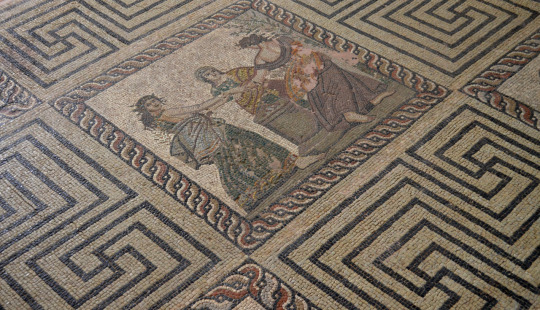
Toss a coin to your blogger, oh valley of plenty? https://ko-fi.com/isabia
Why? Because I wouldn’t kill Renfri in episode one, and then get stuck with meaningless scenes of Ciri wandering about in the moors. I am a better writer, for one. And being on the subject, if I entered a guy’s home and there were nubile naked women running around THAT HE imagined into being, I would turn around and leave immediately.
It would be like entering a horny blog (you know what I am talking about) and the guy there asking me to murder a girl for him. I would be like I know exactly who to murder and it’s not the random girl you are suggesting.
#mosaics#ancient greece#tagamemnon#greece#classical studies#ancient art#greek roman period#ancient culture#greco roman art#greco roman culture#archaeology#greek museums#patra#archaeological museums#museums#ελλάδα#αρχαία ελλάδα#πάτρα#Αχαΐα#ελληνικά μουσεία#μουσεία#μωσαϊκά#ρωμαϊκή περίοδος
200 notes
·
View notes
Text
15 Best Things To Do in Crete: A Local’s Guide
The Greek island of Crete has always been a perfect destination for a relaxing holiday. It’s full of exciting experiences and is ideal for any kind of traveller. In fact, there are so many incredible things to do in Crete that it can be kind of overwhelming deciding where to go on the island!
Crete is the largest island in Greece and offers stunning shores where you can lazily lounge all day long under the warm Mediterranean sun. In contrast, there are imposing mountain peaks and gorges waiting for you to conquer.
Home to a unique natural scenery and endless opportunities for entertainment, it’s always hard to come up with a list of the best things to do in Crete.
I’ve been living on the island for over 4 years now, and have discovered all of the amazing places to visit in Crete, and the top sites and attractions.
This list featuring 15 unique things to do on the island will certainly help you decide why you need to visit Crete at least once in your lifetime — it really is one of the top places to see in Greece.
Here’s my list of the top 15 things to do in Crete, Greece!
1. Discover the Beautiful Beaches of Chania
There are several beaches that you can explore in Crete. Three of Crete’s most famous beaches are in the region of Chania — visit them all or choose the one that best suits your holiday style. Some of the top beaches in Greece are found on Crete, don’t miss them!
Balos Beach and Lagoon
Balos Beach is located towards the end of the Gramvousa Peninsula, about one hour drive from Chania. If you prefer to skip the road to Balos, which is mostly a dirt track next to a steep hill overlooking the sea, it’s a good idea to book a day cruise departing from the nearby harbour of Kissamos.
A day cruise will not only take you to Balos but also to the close-by island of Imeri Gramvousa.
The beach of Balos is one of the most exotic places on the island. The crystal waters form a shallow lagoon that is surrounded by a harsh mountain landscape of striking contrast against the turquoise seas.
The beach is well organized although there’s just one canteen on the beach. If you’re on a budget, I’d suggest you pack your lunch so as to save some money.
No matter whether you visit Balos by car or boat, don’t overlook how merciless the sun can be in Crete. Carry enough water with you and high SPF sunscreen lotion.
Pink Sand Beach of Elafonisi
Elafonisi Beach is another spectacular place to visit in Crete. It’s a worldwide famous shore known for its fantastic pink sand, but also for a fairly calm sea with alluring shades of blue.
The shore is wide and although it can be really packed in summer, there’s always enough space for everyone.
Elafonisi is about 70 km south from Chania, and although there are buses going there from Chania’s central station, the best way to get there is by car.
To reach Elafonisi, you can drive through the gorge of Topolia or combine the trip with a stop on Crete’s third famous beach, Falasarna, driving along the coastal road. For those of you who don’t have a vehicle, join this highly rated trip to Elafonisi Beach.
Falasarna Beach
The wide shores of Falasarna are on the west coast of Crete and it’s the best place on Crete to enjoy the sunset. The village is small and relaxing, with not many things to do.
In fact, the main reason to visit Falasarna is the spectacular bay and the ideal weather conditions that make it a perfect place to practice windsurfing and other water sports.
There are a few beach bars and restaurants serving basic dishes and cold drinks, so you don’t need to pack a lunch if you plan to spend your day in Falasarna.
2. Stroll the Alleys of Chania’s Old Town
The old town of Chania has often been described as Crete’s prettiest city, and for good reason! The old town is home to an elegant Venetian quarter, a romantic old port, a beautiful Egyptian lighthouse, and much more.
The Venetian district of Chania’s old town is the perfect place to admire the stunning urban landscape of Chania. You can also visit the old Jewish neighbourhood of Zudecca which is home to a Synagogue dating from the 15th century.
On the seaside area, you can step into the Ottoman past of the island by visiting the small Mosque of the Janissaries, one of Chania’s best-known landmarks with its typical pink domes and arches.
At night, you can dine in any of the several tavernas that line up along the Venetian Arsenals. This is the perfect spot to enjoy a sunset while sipping a glass of the local Vidiano white wine. Also known as the New Marina, the Arsenals are a great place to experience the unique flavors of Crete.
Choose Salis for a refined dining experience with products coming directly from the producers and the restaurant’s own winery.
If you’re on a budget, instead, go for a round of local meze (small Greek dishes) in Faka. The views of the harbour are equally inspiring in both venues.
To end the day, have a cocktail in Pallas, right in front of the lighthouse. There you can listen to some music and engage in conversation with the friendly locals.
3. Catch a Ferry to Loutro (One of the best things to do in Crete!)
One of the most scenic drives in the region of Chania is the one that takes you all the way down to the southern village of Chora Sfakion, passing through the impressive gorge of Imbros.
Once in Chora Sfakion, reach the port and board a ferry to spend a day… or even two, in the small fishing village of Loutro.
If you’re an experienced hiker or simply just love adventures, you can also reach Loutro by hiking the coastal mountain trail that connects Chora Sfakion to the village. On your way, you can stop and swim in the wonderful hidden beaches of Illingas or Glyka Nera.
There’s not much to do in Loutro, but that’s the beauty of it.
Loutro is the perfect place to relax and enjoy a peaceful holiday, and it’s not unusual for day-trippers to change their mind on the spot and book a stay once they’re there.
You can swim in the emerald green waters and enjoy the simple but tasty local cuisine served in any of the seaside tavernas. My favorite has always been Notos, specializing in seafood but also catering to vegetarians. Their prices are also very budget-friendly.
4. Explore the Local History in Arkadi Monastery
Arkadi Monastery is the most important spiritual center of Crete. A place loved by the locals not only for the beauty of the church and the gardens but especially because of the key role it played during the times of the Ottoman occupation of the island.
The Holocaust of Arkadi is an important event in the past of the island. About 900 people – mostly kids and women -chose to take their own lives rather than surrender to the Turks.
These events did not lead to the immediate liberation of the island but did start a process of international support which, by 1898, finally put an end to 267 years of oppressing ottoman ruling on the island.
Arkadi Monastery is one of the many monasteries of Crete. It is about 25 minutes away from the city of Rethymnon, and if you’re a real fan of local history, it could be a great day trip if combined with a visit to the Archaeological Site of Eleftherna and its museum.
5. Admire the Turkish Architecture in the Old Town of Rethymnon
One more great thing to do in Crete is to pay a visit to the old town of Rethymnon. Rethymnon is not just a gorgeous Venetian town with a picturesque port and a maze of cobblestone alleys, it’s also the place where the rest of the Turkish past of the island is better preserved and easy to discover.
In the town, it’s a good idea to explore the fantastic Venetian mansions with wooden balconies in perfect Turkish style. You’ll also find high minarets, such as the Valide Sultana minaret and the one in the Mosque of Neratzes.
However, the most imposing mosque in town can be visited inside the Fortezza, the imposing Venetian fortress that faces the Sea of Crete.
Once you’re done exploring, you can enjoy lunch or dinner in the old town.
For a quick and light lunch, choose Raki BaRaki for the endless choice of meze. For a more refined meal, Avli is one of Crete’s most famous restaurants. It has a beautiful herb garden and one of Greece’s best wine lists.
6. Go Wine Tasting
It’s impossible to visit Crete and not to come across one of the over 50 wineries that populate the villages of the island. Most wineries are open to the public and produce fantastic wines from 12 different grape varieties that grow only on Crete.
The region of Rethymnon is home to Crete’s star grape, Vidiano, which produces one of the best white wine labels of Crete. One of the wineries open to the public in Rethymnon is Klados, a boutique producer with just 6 labels worth trying.
In Chania, you should make a point to visit Manousakis winery, not far from the center of Chania. If you’re driving to catch that ferry to Loutro, you can check Dourakis winery, on the way to Sfakia.
Heraklion, however, is the most important wine region of Crete.
Lyrarakis winery is one of the most traditional places to visit, you can enjoy a small wine tasting session with a few labels and local cheese, or enjoy a complete meal with a total wine tasting experience.
There are some great wine tours that you can join in Crete, many of which include food as well. Drinking and driving isn’t safe, and by joining a tour, not only will you be able to drink as much as you want, but you’ll meet some great people along the way!
This highly-rated tour includes winery visits, olive oil tasting, lunch, transport, guide and more. This small-group tour offers 15 different tastings, lunch, olive oil, transport, guide and more. Finally, this tour offers a 3-course lunch, wine tastings, a half bottle of wine per person, transport and guide. Cheers!
7. Enjoy The Food and Scenery of Argyroupolis
Half-way between Rethymnon and Chania, there’s a hidden village worth a visit. Argyroupolis is a very special little town that lies surrounded by green valleys, high mountains, and natural springs.
The green landscape is an inviting atmosphere for an afternoon away from the sea, to see a completely different side of the island.
Argyropoulis is famous among locals because it serves on of the island’s best-known dishes, goat on the spit. However, many visit the village for a different food treat.
In Argyroupolis, it’s also possible to eat fresh grilled trout. In fact, not many people are aware of the fact that, despite being an island, the protein of choice is not always fish.
On Crete, fish is mostly for tourists while locals prefer lamb or goat. For great fish, Argyroupolis is the answer.
8. Marvel at Crete’s Ancient Past in Knossos
No visit to Crete is complete without paying a visit to the Minoan Palace of Knossos, about 11 km from the capital of Crete, Heraklion.
Knossos is Greece’s second most-visited archaeological site, right after the Parthenon in Athens, it’s also one of the biggest archaeological ruins of Europe.
The Minoan civilization flourished on the island over 3000 years ago, especially during the Bronze Age, and engaged in trading with other important Mediterranean cultures.
Inside the palace, you can admire unique buildings, storage rooms, and genius engineering inventions, including complex piping systems to provide fresh water to the inhabitants, prevent floods, and flush their toilets.
After checking out the archaeological site, head back to the center of Heraklion to explore the Archaeological Museum. It will shed new light on your recent visit to Knossos, putting everything into perspective.
You will be able to admire the intricate quality of the objects discovered in the archaeological site, currently exhibited in the museum.
The best way to visit Knossos is to book a guided visit. This will bring the site to life, plus you’ll be able to skip the long lines and save a lot of time. This tour includes both the Knossos site and the Archaeological Museum, a 90 minute guided tour with an English speaking guide, and skip-the-line access.
9. Nightlife in Malia
Those who travel to Crete expecting an exciting nightlife scene should maybe reconsider. Crete is not a crazy party island unless you visit the coastal town of Malia!
Malia is a lively seaside town on the northern coast of Heraklion, with a beautiful beach and a great variety of pubs, beach bars, and a few discos to dance the night away.
However, there’s more to Malia than crazy evenings on the dance floor.
The village was also an important Minoan settlement in Ancient times, and today you can devote some hours to visiting the Minoan Palace of Malia, just a few meters from the Sea of Crete.
10. Swim In The Hippie Beach of Matala
The southern coast of the region of Heraklion is famous all over the world for Matala. Matala has been a well-known hippie meeting point since the early sixties, and it was one of the first places where ex-pats would go back to them.
They were not digital nomads, but they were definitely the first expression of modern nomadism and rebellion against the norms.
The hippies of Matala lived for months in the mountain caves that stand right next to the beach, living a simple life free from stress — a unique vibe that this small coastal town managed to maintain through the years. These caves in the rock are one of the more unique things to see in Crete!
Despite being one of Crete’s tourist hot spots, Matala is a tranquil resort to spend a few days disconnecting from the rest of the world. Click here for a day trip to this unique spot.
11. Go Village Hopping Around the Lasithi Plateau
Once you’ve explored the central region of Heraklion, drive to the East. Lasithi is Crete’s easternmost region and as well as the place that best treasures Crete’s mountain tradition.
Probably the most authentic thing to do in eastern Crete is to drive around the traditional villages of the Lasithi Plateau. Some of them are so small, that you’ll need just a couple of minutes to see them.
The plateau is a wonderful green extension, where locals cultivate different kinds of fruits and vegetables, the tavernas cook and serve authentic homemade meals, and the mountain landscape is truly inspiring.
A must stop in the Lasithi Plateau is the small village of Psychro, known for the imposing Cave of Zeus, an ancient Minoan place of worship.
According to different legends, Greece’s most important god, Zeus, was not just born on Crete, but he was also raised inside this cave.
12. Hike the Gorge of Richtis
Not everything is about mountain villages in the east. Along the coastal road that takes you from Heraklion to Sitia, you will find a fantastic natural place to visit that will certainly leave you in awe.
Forget the extremely busy Samaria Gorge, the Gorge of Richtis is one of Crete’s lesser-known walking paths along a small stream. This is one of the most beautiful natural attractions in Crete.
After about an hour hike through the green landscape, it takes you through a tiny but refreshing waterfall, and from there to a beautiful beach on the northern coast of the islands.
To hike the path you need to access the entrance of the gorge by car, and leave it before starting the hike, right next to the parking spot.
The beach is not organized, so take everything you might need, including a beach towel and cold drinks. After the hike, a swim at Richtis beach will be more than welcome!
13. Sunbathe on the Palm Tree Beach of Vai
The extreme East of Crete has some of the most beautiful beaches on the island. Anywhere close to the sea you drive in the region of Lasithi will offer spectacular scenic views and some of the cleanest beaches of Crete, most of them usually empty, since the area is considered to be quite remote.
The beach of Vai is famous for being home to one of Europe’s largest date palm tree groves. It’s located in a protected bay, well-protected from strong winds and sea currents, and the area has amenities such as restaurants, showers, and lifeguards.
Those of you who would rather swim in a more isolated beach will find a good alternative just 5 km away from Vai. The hidden beach of Itanos is another wonderful shore on the east coast, just beneath Ancient Dorian ruins.
The place is truly spectacular during sunset. To best visit the East, chose a place to stay in the nearby city of Sitia or in Agios Nikolaos.
14. Taste the Strong Local Spirit: Raki
You might be wondering what raki is. Well, chances are that raki is the first (or close second!) thing you taste on the island. Let me explain…
Raki (also known as tsikoudia) is a strong, homemade spirit with high alcohol content. It’s served as a complimentary treat after every meal usually together with fresh fruit or another sweet delicacy.
However, raki is much more than just a drink. It’s a welcoming expression of hospitality typical of the island, and it can also be enjoyed before lunch, with a round of olives and acts as a fantastic starter for any meal.
15. Taste the Unique Cretan Cuisine in an Authentic Mountain Village
As I’ve already said, the best way to see the hidden places of Crete is by renting a car and driving around the island.
Driving in Crete is not really that difficult and it allows you to go through spots that you wouldn’t have imagined existed. Besides, it’s impossible to access some of these places using local public transport.
While driving around, you don’t want to miss the most authentic cuisine.
Of course, you’ll be able to taste the well-known Greek gyros while visiting the most important cities, but lunch in a mountain village will be a completely genuine experience of flavor and hospitality.
Just stop whenever you see a small taverna, you will be told the specials of the day and, trust me, no matter what you choose, you will be amazed at the fresh ingredients and unique taste of homemade olive oil, abundant herbs, and the tender meats.
And if you’re a vegetarian, there’s no need to worry, the Cretan diet offers an endless variety of greens and vegetables baked in pies, cooked in tomato sauce, or simply prepared with olive oil, sea salt, and lemon.
16. Bonus! Enjoy a Culinary Tour of the Old Town
No matter where in the world you are, one of the best ways to discover the local culture is through its tastes, aromas, and dishes. And on Crete, flavors are really simple and authentic but full of nuances that will seduce any palate.
In the city of Chania, you can join a gastronomic tour of the city, discover the traditional breakfast of Crete, wander the alleys of the Municipal Market and taste the fantastic cheeses, honey, and extra virgin olive oil produced on the island.
This one here includes all those stops and ends with a fantastic round of meze and raki in the traditional Turkish neighborhood of Splantzia.
Now You Know What To Do in Crete!
Any trip to Crete can feed your wanderlust and ignite your imagination since the initial planning phase. The more you read about the island, the more things you’ll want to experience! Don’t be surprised if you feel the need to add some more extra days to your trip to explore more.
These 15 amazing things to do in Crete just scratch the surface — there’s so much on offer here.
Crete stole my heart and I could never picture myself living anywhere else. Of course not every tourist who visits Crete decides to start a life here, but many do return year after year, always eager to discover more! Will you be the next one?
Images in this article are from Shutterstock.com, a website for sourcing high quality, royalty-free images and videos.
The post 15 Best Things To Do in Crete: A Local’s Guide appeared first on Goats On The Road.
15 Best Things To Do in Crete: A Local’s Guide published first on https://travelaspire.weebly.com/
0 notes
Photo

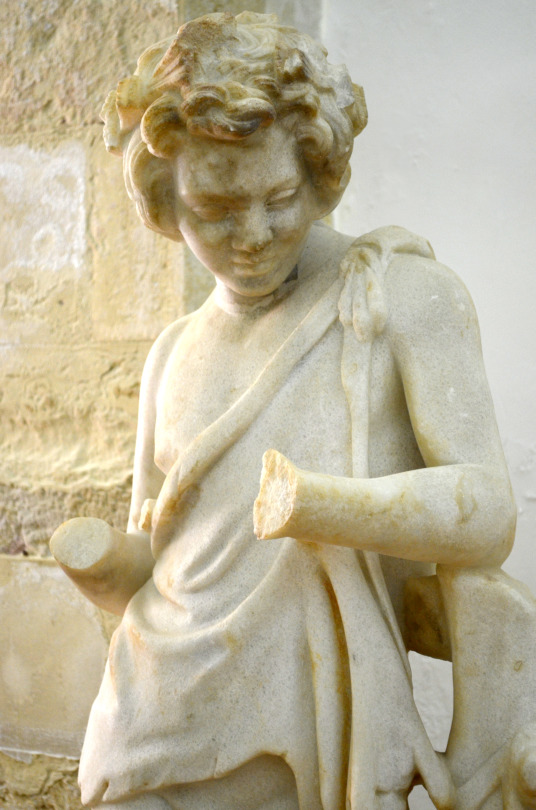
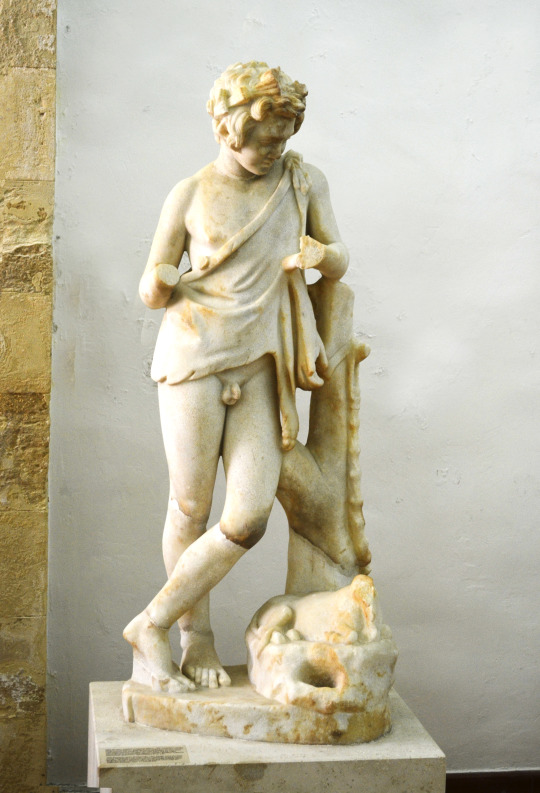
Crete, Archaeological Museum of Kissamos:
Λ694 Kissamos, eastern Roman Baths, 1967. Marble statue of a Satyr resting. He leans on a tree trunk, where a pedum for hunting hares in hanging. He wears a panther’s skin and was possibly holding a flute. Under the trunk, a miniature cow is represented. Loose copy of a Hellenistic prototype. Date 2nd century A.D.
#greece#tagamemnon#ancient greece#archaeological museum of kissamos#kissamos#marble statues#grecoroman statuary#statue#sculpture#ελλάδα#αρχαία ελλάδα#αρχαιολογικό μουσείο κισσάμου#κίσσαμος#καστέλι#μαρμάρινα αγάλματα#γλυπτική#κρήτη#αρχαιολογία#αρχαιολογικά μουσεία#archaeology#archaeological museums#crete
128 notes
·
View notes